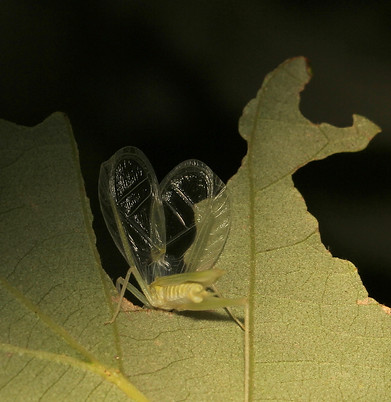Davis's Tree Cricket

Davis’s Tree Cricket (Oecanthus exclamationis)
Occurrence
Possibly common in woodland habitats. Less common than the similar-sounding, abundant Narrow-winged Tree Cricket.
Habitat
Forests, edges, and sometimes lower in younger or ornamental trees.
Range
Throughout our region.
Physical description
Very pale green with only a hint of orange on the top of the head. If you are very fortunate, you may be able to see the delicate green lines on the lower set of wings. The spots at the base of the antennae form an exclamation mark.


Song
An intermittent, irregular trill with short pauses between songs. Unlike the Narrow-winged Tree Cricket, the song-pause pairings are not consistent in length and can be longer. Their songs are also noticeably lower in pitch than those of the Narrow-winged, Broad-winged, and Snowy Tree Crickets.
You can compare the Davis's song with the Narrow-winged's on the Tree Cricket Introduction page

Adult season
Late July until frost.
General description and context
Although they are typically in taller trees, I also find them in young oak (as in the photos below) planted around picnic areas, parking areas, and park roads. At one point, there was a Davis’s singing in the street tree in front of our house (on the “tree lawn,” or “devil’s strip,” depending whether you are in the Cleveland area or the Akron area). The shape of the leaves seems to work well for singing males. This will be your best chance to identify this species, as you will be able to hear individual crickets and possibly even seen them.

Davis's wings down before singing...

...and wings up to sing!
Similar species
Although the Narrow-winged Tree Cricket may sometimes be found at comparable heights, the Davis’s will often be higher in the trees and is unlikely to be found in shrubs. The Narrow-winged’s songs follow a consistent song-pause phrase length while the Davis’s are irregular.
Field observation
It’s not so difficult to hear – and even identify – them when they aren’t up too high. Their pitch is lower than the other crickets, so it stands out as something a little different. I’m less confident about their presence up in the canopy where other crickets and katydids are also singing in a chorus, especially since a chorus of “singers” obscures the rhythm of the individuals. However, I usually hear two different pitches a major or minor third apart in the arboreal chorus. I suspect this is the Two-spotted and the Davis’s.
Listening in Nature
http://listeninginnature.blogspot.com/2016/08/spot-check.html
Songs of Insects
http://songsofinsects.com/crickets/daviss-tree-cricket
Singing Insects of North America
http://entnemdept.ufl.edu/Walker/buzz/590a.htm
Oecanthinae.com (Tree Crickets)
